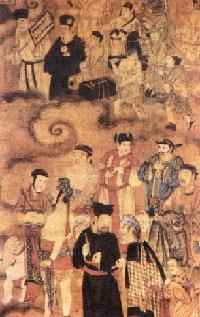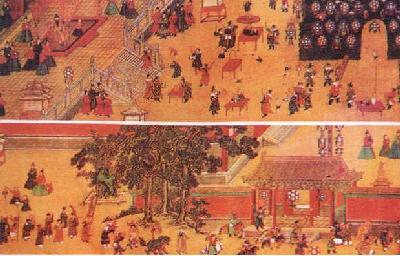|

|
| Acrobatic Artists, a Yuan-Ming period painting depicting Buddhist rituals held to seek happiness for people who died on land and at sea |
The lower section of painting No. 57 shows 11 performers, including jugglers, dwarf magicians and lion dance performers, as well as actors playingZhengmoandJingroles (leading male roles and painted-faces roles) inZajuduring the Yuan and Ming dynasties. The first performer from the left is a chubby male dwarf wearing only red shorts and carrying a bottle on his shoulder The dwarf was probably an acrobat highly skilled in disappearing into containers smaller than his body. Another man resembling a lion dance performer during the Yuan period wears a blue piece of clothing over his shoulder to disguise himself as a lion with bulging eyes and closed mouth. The collar of the clothing and the mane of the lion are visible.
 |
| Ming Emperor Xianzong Makes Merry |
Acrobatics, dance and other traditional performing arts were rarely presented in the royal palace during the Ming and Qing (1644-1911) dynasties, the last two feudal dynasties. Acrobatics in particular was regarded as unrefined and the sole example of its presentation in the royal palace can be found in the painting entitledMing Emperor Xianzong (1465-1488) Makes Merry. The work shows acrobats performing in the royal palace. Acrobatic performers during the Qing Dynasty were forced to roam far from their homes. However, local operas gained great popularity in China during the period. Anhui opera was introduced to Beijing in 1790 and gradually gave birth to a new genre known as Peking opera. Thereafter, great efforts were made to incorporate acrobatics in Peking Opera. As a result,Wuxi(plays consisting mainly of battle scenes with emphasis on acrobatics) came into being and was used as a means to attract theatergoers.
